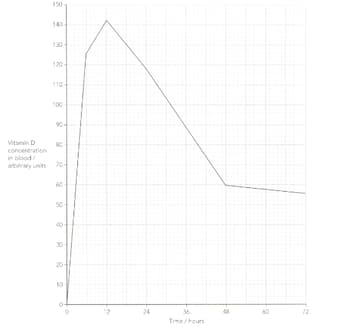Mary Jones and Geoff Jones Solutions for Chapter: Human Nutrition, Exercise 4: Exercise 7.4
Mary Jones Biology Solutions for Exercise - Mary Jones and Geoff Jones Solutions for Chapter: Human Nutrition, Exercise 4: Exercise 7.4
Attempt the free practice questions on Chapter 7: Human Nutrition, Exercise 4: Exercise 7.4 with hints and solutions to strengthen your understanding. Biology for Cambridge IGCSE Workbook 4 th Edition Digital Access solutions are prepared by Experienced Embibe Experts.
Questions from Mary Jones and Geoff Jones Solutions for Chapter: Human Nutrition, Exercise 4: Exercise 7.4 with Hints & Solutions
In an investigation into the absorption of vitamin D from the alimentary canal, a volunteer ate a measured quantity of vitamin D on a piece of roast. Blood samples were then taken from him at intervals over a period of 72 hours, and the concentration of vitamin D in each blood sample was measured.
The results are shown in the graph in figure 7.2.

Describe the changes in the concentration of vitamin D in the blood over the 72-hour period.
Calculate the percentage change in vitamin D concentration between 12 hours and 48 hours. Show your working. Give your answer to the nearest whole number.
Name the part of the alimentary canal in which vitamin D is absorbed into the blood.
Explain how this part of the alimentary canal is adapted to make absorption efficient.
Explain why vitamin D does not need to be digested before it is absorbed.
Vitamin D is soluble in fat, but insoluble in water. It is present in the fat component of foods that eat.
Use this information to suggest how bile helps to absorb vitamin D from food.
Vitamin D is soluble in fat, but insoluble in water. It is present in the fat component of foods that eat.
Suggest into which part of the villi is absorbed. Explain your suggestion.
The volunteer was asked not to expose his skin to sunlight during the investigation. Suggest why this was done.
